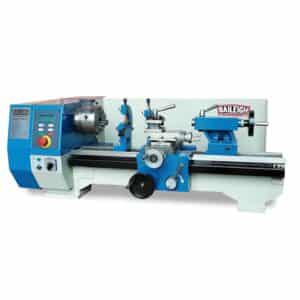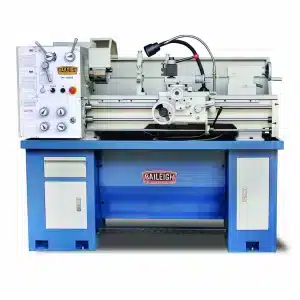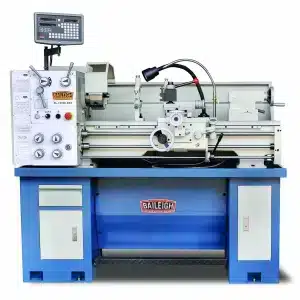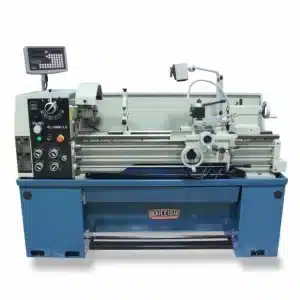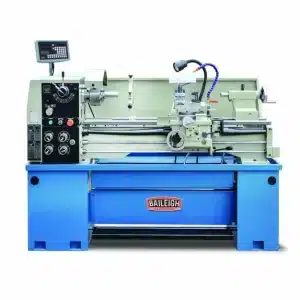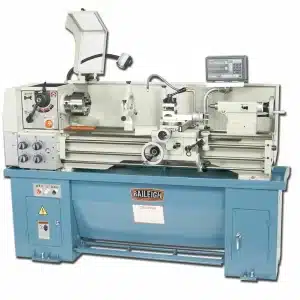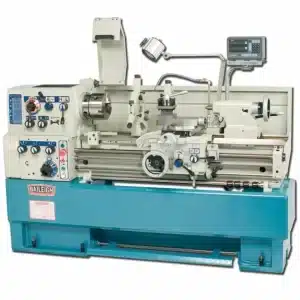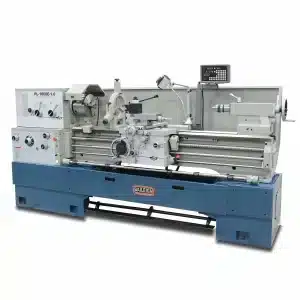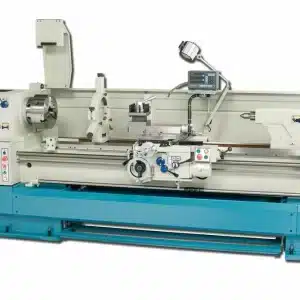Working Mechanism and Industry Applications
Before learning how this machine works, it is essential to know about its parts. Most Lathes consist of the following:
- Bed: Machine Body
- Headstock: It is part of the body of the machine, connected to the motor and gearbox.
- Tailstock: It is the part that sits on the bed and moves right to left to create parts.
- Spindle: Also connected to the machine body, it is basically what turns to create the parts.
- Motor
- Chuck: Holds the piece to be worked on. Could have 3 or 4 jaws to grab the material.
- Cutting Tools: These are the consumables and there are 100s of different types, shapes and options.
How does it work?
The piece to be worked upon is placed between the headstock and tailstock. It is buckled with the chuck that helps put the workpiece into a stable position by gripping it from the outside. The workpiece is rotated with the help of a spindle which is connected to a motor. It makes the workpiece rotate at its axis. A cutting tool is then placed in the tool holder that holds the cutter at an appropriate distance from the rotating workpiece so its blades can cut the workpiece as desired. Different types of cutting tools are used for different desired shapes and materials.
A Lathe spins a material and presses a tool (insert) against it to process it. It can be used for various types of machining depending on the type of cutting tool used and how it is moved. In general, it is possible to perform outer diameter machining, inner diameter machining, end face machining, thread machining, groove machining, hole machining (drilling), taper machining with an angle such as conical shape, and circular arc machining. A combination of these various machining methods is used to complete a single part. The process design is to define what kind of cutting tools are used, the processing method, and the processing order. The machining is done by changing the tool and moving it in accordance with the process order. Although it requires the skills of a craftsperson to operate the machine, it’s useful for quick delivery of a single product or detailed modification of a processed product.
Key Features of Industrial Lathes
The most important feature when considering buying a Lathe is the size of the bed of the Lathe. You’ll find Lathes described as “14 in. by 40 in.” Lathes. For instance, a Baileigh PL-1440E Metal Lathe has a 40” distance between centers (i.e., the headstock and tailstock) or the longest piece of material that a Lathe can handle, and it can handle a maximum diameter of 14”. This is also known as the “swing” of the Lathe. Most hobbyists and craftspeople working on smaller pieces will find that a 3” x 15” Lathe is typically as small as one should go, while about double that size, 6” x 30”, forms the upper end of what a home Lathe can be.
A very important feature to look for when buying a Lathe is its weight. As with many pieces of machinery, Lathes can be quite heavy. The sizing as given is not the dimension of the Lathe itself, but rather of the workpiece which can be accommodated; the Lathe will be significantly larger. A 3” x 15” Lathe can easily weigh more than 30 kg; a Lathe double that size would weigh far more, and require an engine lift or small crane to move into place.
All Lathes will have a power chart, alongside speeds and feeds. One must consider the motor specifications when buying a new Lathe. While some Lathes operate at a single speed, many will have multiple speed settings. There is also the matter of torque to consider. For cutting larger pieces, your Lathe will need more than just high RPMs; it will need the power to keep a heavy workpiece turning and cutting smoothly. Advertisers may proudly proclaim maximum RPMs for their Lathes, but minimum RPMs can be even more important for operations such as screw-cutting.
Buying a Lathe is a bit of a complicated process, but you’ll be helped immensely if you keep the project in mind as you shop. What are you intending to use the Lathe for? With that project as the determining factor, the necessary complexity of the Lathe and any size or weight restrictions will become apparent. You’ll be able to make a much more informed decision if you keep the needs of your project foremost.
Safety and Maintenance Tips for Industrial Lathes
As with many other types of equipment, a Lathe must be used by trained personnel only and the safety guidelines and procedures around a Lathe are of extreme importance. There are many potential hazards that accompany a Lathe such as: Flying objects such as the chuck key left in the chuck; cutting tool injury when cleaning filing or polishing; hair/clothing getting caught in moving machine parts; metal splinters; and swarf and eye injuries.
Always wear PPE like safety glasses, protective shields, and ear plugs and never wear loose clothing or gloves as these can get caught on the machine’s inner workings and the results would be catastrophic.
A few guidelines and procedures to keep in mind are:
- Familiarize yourself with all machine operations and controls.
- Ensure all guards are fitted, secure, and functional.
- DO NOT operate if guards are missing or faulty.
- Check the job is clamped tight in the chuck.
- Remove all tools from the bed and slides of the machine.
- Ensure the correct speed for the machining process is selected.
- Remove the chuck key before starting the Lathe.
- Always switch off the machine before making adjustments or measurements.
- Switch off the machine when work is completed and reset all guards to a fully closed position.
- Avoid letting swarf build up on the tool or job. Stop the machine and remove it.
- Leave the machine in a safe, clean, and tidy state.
Install safety interlocks or trip systems that automatically shut down the equipment in case of abnormal conditions, such as high temperature, low oil pressure, or excessive vibration. These interlocks act as safeguards and help prevent catastrophic failures.
The don’t list when using a Lathe are:
- DO NOT use faulty equipment.
- DO NOT try to lift chucks or faceplates that are too heavy for you.
- NEVER leave the machine running unattended.
- DO NOT attempt to slow or stop the chuck or revolving work by hand.
As far as maintenance goes, a Lathe must be maintained thoroughly daily, weekly, monthly, and before and after each use. To avoid major issues, don’t neglect the maintenance of your Lathe.
Always follow manufacturer guidelines as far as installation, startup, shutdown, maintenance, and safety precautions go. Regularly monitor vibration levels and noise emissions from rotating equipment. Excessive vibration or unusual noise can indicate misalignment, imbalance, or other issues that may lead to equipment failure. Address these issues promptly to prevent further damage. Follow the manufacturer’s recommendations for lubrication and ensure that rotating equipment is properly lubricated. Inadequate lubrication can lead to increased friction, overheating, and premature wear of components. Continuously monitor operating parameters such as temperature, pressure, flow rate, and electrical currents. Deviations from normal operating ranges may indicate potential problems that require attention.


